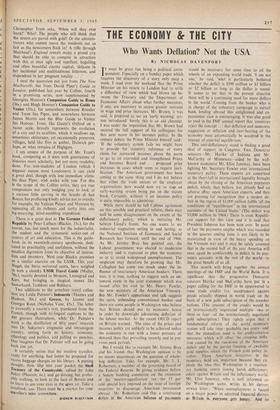Travellers' Tales
BATSFORD have courageously allowed two writers, William Gaunt on Oxford and Barbara Willard on Sussex (both 25s.), with lifelong knowledge and affection for their much de- scribed domains, to publish a reappreciation. Miss Willard shows us her Sussex as it lies be- tween its mainly south-flowing rivers, Lavant and Arun, Ouse and Cuckmere, a helpful way to bring order into kaleidosCopic chaos. Pro- fessor Nikolaus Pevsner and Ian Nairn, making a few but muted outcries, have split their Sussex (Penguin, 30s.) into East (Pevsner) and West (Nairn). It is a staggeringly comprehensive addition to a distinguished series, which still has twenty volumes to come.
Writing about town rather than country, Mr.
Gaunt looks at, the layers of history in Oxford, from medimval to modern, the relation of past
and present represented by his not quite in- conclusive restatement of the argument abimt which college is the most antique, Balliol, Merton or University College. He gives the prize to Walter de Merton's foundation.
It is this sort of personal interest, preference, or prejudice, that marks out the travel book from the guide. Not that guidebooks are altogether impersonal, though they may read as if they are, for even the veteran Russell Muirhead and his successor Stuart Rossiter express views, if only in the selection of sites to see. Mr. Muirhead has just retired after nearly half a century of producing the famous Blue Guides, two of the latest being London (ninth edition, Benn, 22s. 6d.) and England (seventh edition, Berm, 50s.), the London revision credited to Stuart Rossiter alone. These are extremely detailed and thorough guides.
Significantly, both London and England have undergone great changes since the' previous editions of these guides, and the London volume has expanded a little to take in some of the Greater London Council area (though what 3 waste of London lies outside the tourist ambit), With a population of more than eight million. nearly ten times the number that were counted in the first census of 1801, the wen's groWth seems unstoppable. Commenting on this in Greater London: Its growth and development 'through two thousand years (Phoenix, 630, Christopher. Trent asks, When will they ever learn?' Who? The people who still think that the streets are paved with gold? Or the adminis- trators who cannot move the residents out as fast as the newcomers flock in? A riffle through Muirhead's England reveals many a proud city that should be able to compete in attraction with this at once ugly and repellent, beguiling and often beautiful county capital, 'delicate in her incidental and multitudinous littleness, and stupendous in her pregnant totality . .
I steal the quotation not just from The New Machiavelli, but from David Piper's Guide to London, published last year by Collins, fourth in a promising series, now supplemented by Georgina Masson's Companion Guide to Rome (36s.) and Hugh Honour's Companion Guide to Venice (30s.), for somewhere between Rossiter and Trent lies Piper, and somewhere between James Morris and the Blue Guide to Venice' lies Honour. Trent, like Gaunt's Oxford on a vaster scale, bravely represents the evolution of a city and its satellites, which it swallows up, sometimes obliterates, yet occasionally preserves, villages, held like flies in amber, Dulwich per- haps, or what remains of Highgate.
1 am unsure of the purpose of Mr. Trent's book, competing as it does with generations of histories more scholarly, but not more readably, done. For non-students of London (which I suppose means most Londoners) it can yield a great deal, though with less immediate stimu- lus than Piper, who walks with you. For this is the scope of the Collins series, they are true companions not only nudging you to look at a curious little carving in the Scuolo di San Rocco, but proffering kindly advice not to overdo, for example, the Vatican Palace and Museum by squeezing all its richness and rarity into one leg-wearying, mind-numbing expedition.
There is a great deal in The German Federal Republic by Peter Latham (Blackie, 35s.), for the tourist, too, but much more for the industrialist, the student and the systematic seeker-out of centres of art and education. This is the guide- book in its twentieth-century apotheosis, dedi- cated to practicality and usefulness, without the smallest digression from its objective of instruc- tion and inventory. Next year Blackie promises us a similar exercise on the USSR. This year Nagel, the Swiss universal aunts, have weighed in with a chunky. USSR Travel Guide (Muller, 70s.), mainly devoted to Moscow, Leningrad and Kiev, but bringing in magical names like Samarkand, Tashkent and Bukhara.
Two additions to the armchair travel collec- tion are Leslie Palmier's Indonesia (Thames and Hudson, 30s.) and Greece, by Jeanne and Georges Roux (Nicholas Vane, 45s.). The latter is avowedly a tourist's text, translated from the French, though with tri-lingual captions to the 400 gravure illustrations, while' Dr. Palmier's work is the distillation of fifty years' research into Dr. Sukarno's enigmatic and intransigent country, setting forth its history, economy, ethnology and politics, and pulling no punches. One imagines that Dr. Palmier will not be going back just yet.
It certainly seems that the modern traveller, ready for anything, had better be prepared for excess baggage charges on his library. A parting thought, then. Slip into your pocket the Shell Treasury of the Countryside, edited by John Baker (Phoenix, 6s.), and go driving, but prefer- ably walking, to look at the face of Britain and to learn to use your eyes in the open air. Take a notebook, too. There must be a market for your traveller's tales somewhere.
. ANDREW ROBERTSON































 Previous page
Previous page